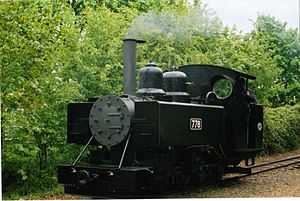Baldwin Class 10-12-D
| Baldwin Class 10-12-D | |
|---|---|
|
No. 778, preserved at the Leighton Buzzard Light Railway | |
| Type and origin | |
| Power type | Steam |
| Builder | Baldwin Locomotive Works, American Locomotive Company |
| Build date | 1915 |
| Specifications | |
| Configuration | 4-6-0PT |
| UIC classification | 2′C n2t |
| Gauge | 600 mm (1 ft 11 5⁄8 in) |
| Leading wheel diameter | 1 ft 4 in (0.406 m) |
| Driver diameter | 1 ft 11 1⁄2 in (0.597 m) |
| Wheelbase | Coupled: 5 ft 8 in (1.73 m) |
| Locomotive weight | 14.5 long tons (14.7 t) (see text) |
| Fuel type | Coal |
| Fuel capacity | 0.75 long tons (0.76 t) (see text) |
| Water capacity | 476 US gal (1,800 l; 396 imp gal) |
| Boiler pressure | 178 psi (1.23 MPa) |
| Cylinders | Two, outside |
| Cylinder size | 9 in × 12 in (229 mm × 305 mm) |
| Valve gear | Walschaerts (slide valves) |
| Performance figures | |
| Tractive effort | 6,258 lbf (27.84 kN) |
| Career | |
| Operator(s) | War Department Light Railways, North Western Railway, Welsh Highland Railway, Glyn Valley Tramway, Snailbeach District Railways, Ashover Light Railway |
| Preserved | No. 778 and No. 794 |
| Current owner |
Leighton Buzzard Light Railway (778) Welsh Highland Railway (794) |
| Disposition | 5 known preserved |
The Baldwin Class 10-12-D was a class of narrow gauge 4-6-0 pannier tank steam locomotives built by the Baldwin Locomotive Works (USA) for the British War Department Light Railways for service in France during World War I. They were built in 1916-1917 to 600 mm (1 ft 11 5⁄8 in) gauge.
Origins of the type
The French (or actually the Belgians) had designed 600 mm gauge 2′C n2t locomotives as early as in 1900–1901 for Chemins de Fer du Calvados. The prototype was Tubize factory type 73. Weidknecht used these drawings and built similar 11-ton locomotives with subcontracted boilers, presumably built by S.A.Energie, Marcinelle.
The French military circles became interested in this 2′C n2t locomotive type for their Decauville Light Military Railways in Morocco. A little heavier 14-ton type was designed and an order was placed for Weidknecht to produce these locomotives for the 600 mm gauge lines in Morocco.
Weidknecht delivered 10 more in 1913 for Chemins de fer Militaires du Maroc numbered (W1-W5 and 1-5).
Baldwin built locomotives
For the French Government
When the Great War broke out in August 1914 the French lost most of their locomotive building capacity in the Northern France to German occupied area. Therefore the French Army demanded fast replacement of the locomotive building capacity for their useful 2′C n2t type which had proved to be a reliable locomotive type for the lightly laid military railways.
Three steam locomotive type drawings were sent to Baldwin Works (finance guaranteed by the French Government) for production of C n2t, 2′C n2t, and light Mallet B′B n4v for 600 mm (1 ft 11 5⁄8 in) gauge lines. With the usual American liberty, Baldwin Drawing Office produced their "version Americaine" of these locomotive types. The first C n2t (based to Decauville design) came out in November 1914 and the first batch of 2′C n2t in January 1915. Only two more batches were built for the French.
For the British War Office
The reason why the British War Office decided to adopt the type as its principal military steam locomotive is uncertain but Baldwin started production in 1916 and built 495 locomotives between October 1916 and April 1917. All were delivered except for nine which were lost at sea.[1]
Use outside Europe
Some of the class found during war their way to other theatres of war than Europe. Baldwin 45163–45222 from batch No 1001–1104 were renumbered by the British War Office to War Department Light Railways, Middle East No 581–640 and were shipped to Egypt to be used in Sinai and Palestine during the British 1917 offensive against the Turks. After the war most of them remained in Middle East.
Peacetime service
After the war many of these locomotives were sold and went on to work in France, Britain and India. Indian North Western Railway received fifty locomotives and numbered them to NWR No 1–50. Unfortunately their later fate is mostly unknown. British narrow-gauge railways which used them included:
Preservation
Four Baldwin Class 10-12-D locomotives have been preserved in the UK:
- No. 778, Leighton Buzzard Light Railway
- No. 794, Welsh Highland Railway
- Works Nos 44657 of 1916 and 45190 of 1917, repatriated in March 2013 by the Statfold Barn Railway
One other locomotive (Baldwin 45215 of 1917) is preserved on the Dreamworld Railway in Coomera, Queensland, Australia. This locomotive worked on a sugar mill in Mackay and prior to the opening of Dreamworld in 1981 after purchase was heavily modified, including a tender, Wild-West style chimney, and conversion to oil-firing. It is currently under overhaul.
In fiction
The fictional No. 2 (later Stanley) in The Railway Series by the Rev. W. Awdry was based on this engine.
References
- ↑ Davies, W. J. K., Light Railways of the First World War, David & Charles, 1967, page 147
Sources
- Davies, W. J. K. (1967). Light Railways of the First World War. David & Charles.
- Neale, Andrew (1988). War Department Light Railways locomotive works list. Croydon, Surrey: Plateway Press.
